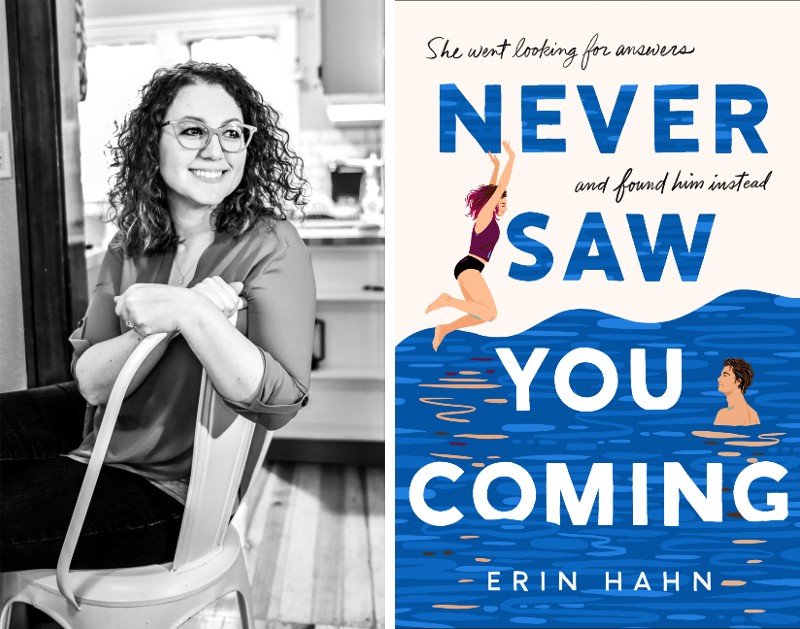The characters in Erin Hahn’s coming-of-age novel "Never Saw You Coming" grapple with beliefs and trauma in Michigan’s Upper Peninsula

The line between right and wrong is not always clear. Erin Hahn’s new young adult novel, Never Saw You Coming, illustrates the dilemmas that people face when they are told one thing and experience another, leaving them to sort out what they believe.
In the book, 18-year-old Meg Hennessey learns several family secrets at once and goes on a journey to make sense of it all. She grew up in Ann Arbor and travels to Marquette, Michigan, to meet with relatives she previously did not know she had. There, she meets Micah Allen, who likewise has a complicated past. The two of them find an immediate connection complete with witty banter, physical attraction, and outdoor adventures. Chapters alternate between each of their perspectives.
As young adults going through new situations and developing strong feelings for each other, Meg and Micah face uncertainties about whether to listen to religious advice or to follow their intuitions. Purity and abstinence are highly valued in the church, and the pair meets scrutiny even when trying to support church members and follow their values.
Meg reflects, “Before Marquette, I was only a sinner in my heart. Now I’m … out there. Like toothpaste all squeezed out of the tube. I can’t be put back in. And I don’t think I want to be.” She reconsiders the good that can come from bad situations. Her parents’ circumstances are among those situations, and she wonders about the concept of sin:
If God brought my parents together that one time, just to make me, and if it was a blessing planned by God, how could it be a sin? Are sins just blessings being played in God’s long game?
Both Meg and Micah grow and form their own perspectives as they face numerous challenges.
Hahn lives in Ann Arbor, and Never Saw You Coming is her third book. I interviewed her about writing this novel, the choices she made in it, and what’s coming up next for her.
Q: What led to you becoming a writer and living in Ann Arbor?
A: I moved to Ann Arbor in 2014 because my husband was hired by the City of Ann Arbor to work as a stewardship specialist with Natural Area Preservation. That was kind of unrelated to me becoming an author, but moving to Michigan from Illinois did force me to take a year off working full time to stay home with my youngest who wasn’t yet old enough for school. That year, the two of us explored Ann Arbor and every city park and library branch we could before she’d rest in the afternoon and I’d write the novel I’d talked about forever. I’d always been a writer, but it wasn’t until I’d finished my first novel that I felt like an author.
Q: Your latest book, Never Saw You Coming, is a young adult book. You write in your “Author’s Note” about why you made this choice. Could you share with Pulp readers why you chose young adult fiction?
A: YA is such a revealing and challenging age to write for. I specifically write “coming of age” novels that typically bridge the cusp of finishing high school and entering into adulthood … whatever that might look like. I graduated high school at 17, met my husband my first day of college that same year. So, for me, I relate most to finding love at that stage of my life. It’s what I personally experienced and what I can most easily bring to the page. It’s also when I learned the most about myself; the age I learned the kind of adult I wanted to be. It’s when I found my faith, my interests, and when I slipped into the comfortable sense of “this is what Erin Hahn looks like.” That period of your life is full of conflict, messy emotions, and wonder. It’s when you often challenge the beliefs and standards you were raised with and I wanted my words to support and reflect that for my young readers. It’s my chance to encourage them by saying, “This is a totally normal experience, and you can absolutely embrace it with both hands!”
Q: How do you channel the voices of young adult characters? Any writing practices that you find helpful?
A: I don’t know that I do anything special to channel the age so much as the character. I don’t set out to write “19-year-old boy"; rather, I work to channel “Micah Allen.” I do a lot of prep work beforehand, to get to know my characters. I create specific playlists for each of my main characters ahead of time that I can refer back to as I draft. I’ll use Pinterest to create an aesthetic for my characters and character sketches with things like their favorite colors to favorite books and typical clothing choices. As far as keeping the voice appropriate to the age range, maybe that’s a bit of luck? My brain is very YA-oriented. I read a lot and listen to a ton of contemporary music. I pay attention to social media and soak up material like a sponge whenever I can.
Q: In the “Author’s Note,” you also mention your journey to finding a publisher for your books. Tell us about the process.
A: As I mentioned earlier, I started writing novels in 2014 or somewhere about there. I wrote maybe five before I found my agent with my sixth. You read that right. It took me a LOT of books and close to 300 rejections before I found my literary agent, Kate McKean, in 2016. I was actually walking out the door to attend my dear friend Karen McManus' (One of Us Is Lying) debut launch in Boston when I got the call. From there, we put You’d Be Mine on submission to editors, and a month later it was picked up by a brand new imprint of MacMillan, Wednesday Books. My original editor ended up leaving three weeks later, but it was then that I started my partnership with Senior Editor Vicki Lame. Together, we’ve published You’d Be Mine in 2019, More Than Maybe in 2020, and Never Saw You Coming this past September. I am working on my fourth YA to be released sometime in spring 2023 and have also sold three adult romances that will start releasing in fall 2022. It’s been a busy few years after a pretty slow and painful start!
Q: Meg Hennessey is a side character from a previous book. What characteristics made you want to tell her story?
A: Meg has always been an utter delight to write. She’s so determinedly joyful. She will make lemonade out of lemons if it kills her, and I adore that. But to be honest, I actually didn’t want to tell her story! I knew all along that she had this kind of “spiritual gap year” to face and I didn’t want it on the page because then I would have to put myself through it as well. I wasn’t ready to face my own story! When we left Meg in More Than Maybe, she was doing so well! I knew to write her story, I would have to break her and then fix her and in doing so, I would face a lot of grief—from my characters, yes, but also my readers. In the end, I couldn’t resist. I didn’t want to leave Meg to stagnate. She deserved to grow and piece herself back together to be the wonderful adult she was meant to be, and I knew I was the one to put this very special, very challenging kind of story on the page. It’s impossible not to root for Meg to find her peace.
Q: Never Saw You Coming covers topics that include prison, suicide, and sexuality, all of which are part of our lives. Writing about them with characters who are encountering them for the first time and for a young adult audience means taking a different perspective. How did that shape how you told the story?
A: In a lot of ways, Meg and Micah are very mature for their age. Particularly, Micah. He was forced to grow up quickly because his father went to prison when he was 13, so his perspective is special. He is a bit of a leader, almost pastoral, in the way he encounters not only his issues but Meg’s as well. He’s got a lot of hard-earned wisdom for 19. That said, his emotional responses are still those of a young adult or teen. He’s not able to completely control his reactions. Meg is almost the opposite from him, so she complements him very well. Where he is wise, she is pretty naïve. Where he is emotionally stunted, she is very comfortable feeling what she is feeling and feeling it all the way down. Because I write dual perspective POVs in my romances, I work to find the balance between them. When one falls, the other lifts them up and vice versa.
Q: In particular, Meg faces conflict with the purity culture in church. What do you hope readers take away from the narrative?
A: That they are loved just as they are. Humans are meant to be messy and fallible. We’re meant to feel things, intensely and we’re called to be curious and make mistakes. God created us exactly that way. I think purity culture, as a whole, is really asking young women especially, but men as well, to stop acting like humans. To hold themselves apart and above everyone else. It paints women as pillars of virtue and goodness while negating emotion altogether. It cancels out feeling, not only physically, but emotionally. And it’s asking them to be that way until their wedding night, until which point, they are to immediately and enthusiastically cast all of that away within the confines of their bedroom. Which is a joke, frankly. It’s damaging and I hope that by shining this light on it, through the eyes of Meg, in particular, readers will be able to see clearly how impossible that is.
Q: Relatedly, the characters get judged on their actions by others. Things deemed bad or sinful by some people are, in contrast, right for others. The novel calls into question the judgments among people, including those in positions of power and religious leadership. Should any of them be judging each other in the first place?
A: The short answer is no. In a perfect world, we wouldn’t judge each other. But as a contemporary author, I’m not tasked with writing a utopia, I’m tasked with reflecting the realities of the world in a way that readers can see themselves within the pages. I think, as readers, we learn so much through empathy and when a beloved character is judged wrongly or misunderstood, it packs a whole lot of punch. We may feel more fury on behalf of a Meg or Micah than we allow for ourselves and maybe that will help create change?
Q: What other books are you reading these days?
A: Oh, gosh. So many. But some of my favorite YA romances coming your way this fall were/are:
How Moon Fuentes Fell in Love With the Universe by Raquel Gilliland Vasquez
Our Way Back to Always by Nina Moreno
Sway With Me by Syed M. Masood
Q: This was your third book. Can you tell us more about your other books in the works?
A: So as I previously stated, I’m writing my fourth YA as we speak, which I have nicknamed my “sad rodeo book” if that tells you anything! My first adult romcom, Built to Last, is a second-chance romance that features two former child stars who are brought together as adults to star on a house-flipping reality show that takes place in Northern Michigan. I’ll have two more romcom spin-offs in that series coming your way from Macmillan/Griffin in the coming years!
Martha Stuit is a former reporter and current librarian.



































Comments
I am intrigued by this book!…
I am intrigued by this book! Will AADL be carrying it? I searched the catalog but didn't find anything...
Thank you for your help,
Anna